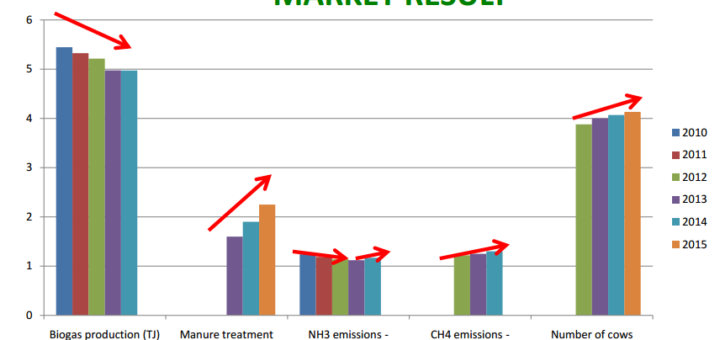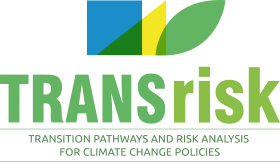Integrated Manure Management (IMM) is a transition pathway in the livestock sector used as a case study in this report. It is an alternative to reducing livestock (RL) numbers and both can be scored in terms of their contribution to meeting environmental targets. With a better understanding of the side-effects of alternative pathways, it will be easier to develop a more robust and integrated policy framework for low-carbon transitions in the livestock sector.
Within the TRANSrisk project one of the Dutch case studies focuses on low-carbon transitions in the livestock sector. The first transition pathway considers Integrated Manure Management (IMM). IMM combines a set of technologies including stable and floor systems, manure handling-storage systems, anaerobic digesters as well as manure/digestate treatment (possible configuration shown in Figure 1).
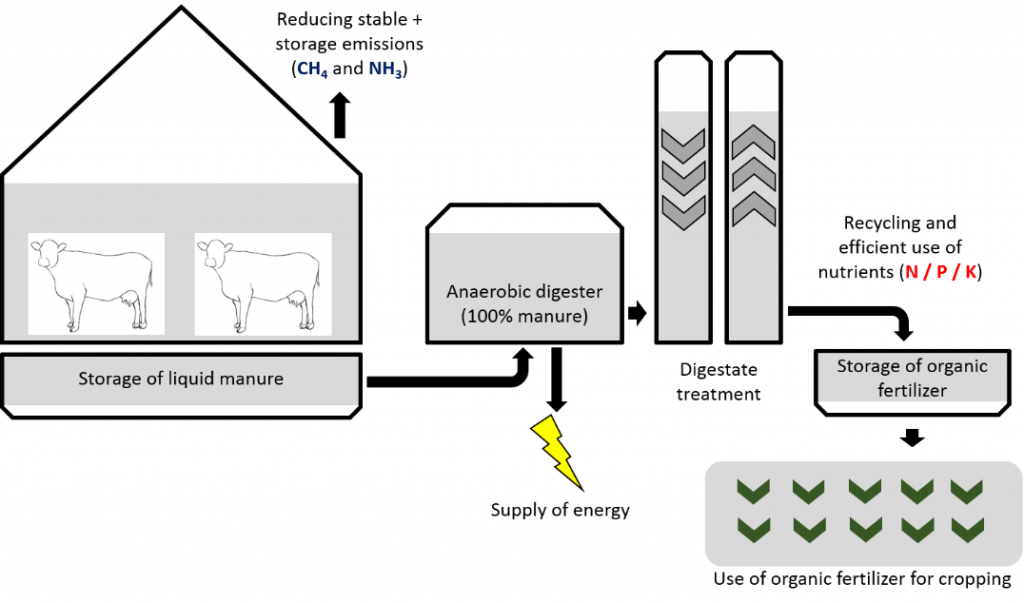
IMM results in the production of biogas and organic fertilisers, while reducing emissions of methane (CH4) and ammonia (NH3). An alternative to IMM is a reduction of animal numbers in the sector. This second transition pathway could achieve a similar (not identical) environmental performance as with IMM.
While deliberately decreasing or limiting the size of the important livestock sector in the Netherlands (≈3% of GDP) may seem odd, there are clear signals that a decline of livestock farming is upcoming. In recent years, societal concerns and environmental impacts have increased in parallel with the growth and industrialisation of the sector. This occurred in an extremely livestock-dense region (Figure 2). Limiting further growth of the sector to mitigate the existing health, safety and/or environmental risks, hardly seems sufficient knowing that a substantial reduction of various impacts is needed. In this case study a reduction of livestock (RL) is considered to be a realistic alternative low carbon transition pathway.
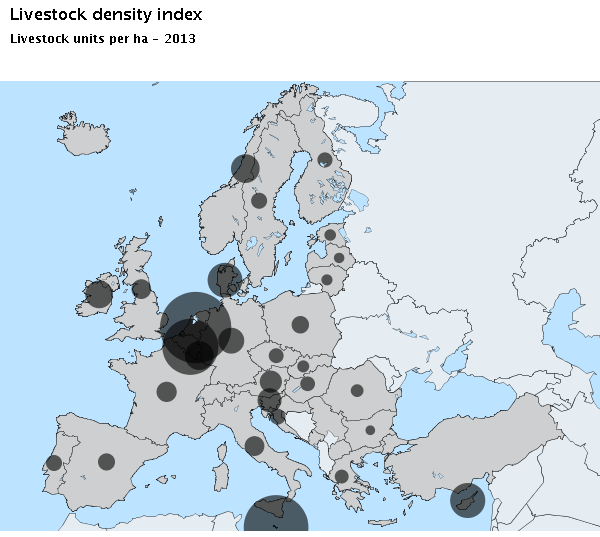
Environmental targets
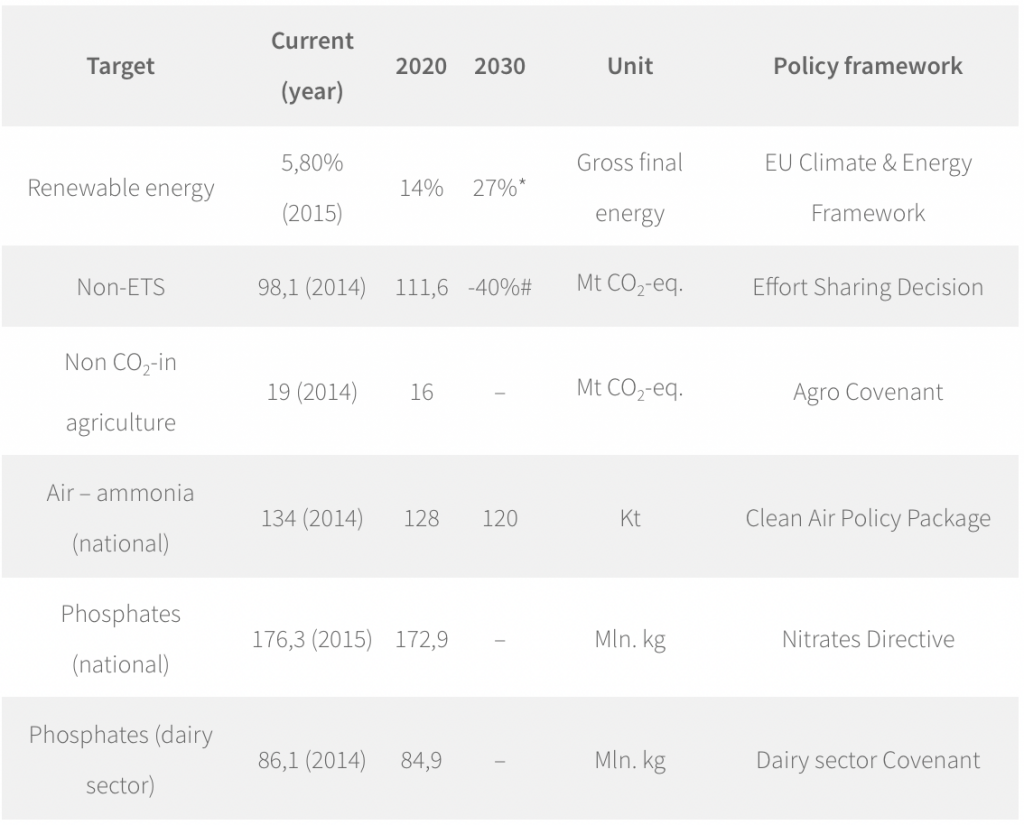
*At the EU level. National targets are not foreseen.
# EU level target for GHG is -40%, but an effort sharing decision with national targets for the Non-ETS sectors at the member state level is foreseen.
Sources: www.emissieregistratie.nl and CBS for current energy and environment data & EU Directives and sector covenants for quantitative targets 2020/2030
Table 1 shows key environmental targets relevant for the livestock sector. It also shows the current status of achievement for the 2020-30 targets. As agriculture is the sector with the highest emissions of CH4 and NH3 (resp. 67% and 87% of national total) it is to be expected that a significant share of the required mitigation burden will fall on its subsector – livestock. With regards to phosphate excretion, the Dutch livestock sector is producing considerably more manure (i.e. nutrients) than is allowed to be spread on agricultural soils under the EU Nitrates Directive. On the short term (2020), meeting the NH3emissions and phosphate excretion targets appear to be most problematic. In the run up to 2030, it is also likely that reducing CH4 emissions from livestock will become more urgent. On the positive side, manure digestion can significantly contribute to the production of renewable energy.
Scoring of pathways
Both low-carbon transition pathways (IMM and RL) can be ‘scored’ in terms of their contribution to meeting these environmental targets. The IMM pathway positively contributes to reducing CH4, CO2 and NH3 emissions, and increases the production of renewable energy, while it has a neutral effect on the excretion of nutrients. The RL pathway results in reduced emissions of CH4, NH3, as well as reduced excretion of phosphates and nitrogen. On top of these environmental effects both pathways also have a number of other socio-economic and environmental side-effects. The RL pathway would result in a direct loss of GDP as meat and dairy output decreases substantially, while the IMM pathway could be considered more suitable for animal health as the in-stable climate improves due to shorter manure storage times. The RL pathway could also lead to a lower level of international cost-competitiveness of the Dutch agricultural sector (i.e. cropping), as at some point a shortage of cheap soil nutrients might arise. This could result in higher use of fossil fertilisers and cover crops. Also in terms of domestic employment both pathways have a different impact.
Next steps
The next step within the TRANSrisk project is to quantify these (and other) effects with the help (macro-)economic models and to further explore the relative importance of these side-effects when it comes to implementing a certain low-carbon transition pathway. With a better understanding of the key side-effects of alternative pathways it will be easier to develop a more robust and integrated policy framework to foster a low-carbon transitions in the livestock sector.
Author: Eise Spijker (JIN)
The full Working Document can be downloaded from the TRANSrisk project website.

This article is an output of the EU-funded TRANSrisk project.
TRANSrisk
Project details
- Project title: “Transitions Pathways and Risk Analysis for Climate Change Mitigation and Adaption Strategies” (TRANSrisk)
- Funding scheme: European Union Horizon 2020 Programme (EU H2020, grant agreement no. 642260)
- Duration: 3 years (1 September 2015 – 31 August 2018)
- Project coordinator: Science Policy Research Unit, University of Sussex, United Kingdom
- Project website: www.transrisk-project.eu

